Storms and construction work

While my own walk round Cairn Gorm on my week in Speyside was affected by a heavy shower (see here) , I hate to think what might have happened had the torrential downpours which occurred in Grantown and Glen Banchor a few days before before (see here) had hit the mountain.
The risks were recently illustrated by the destructive landslide at Atami in Japan, following which:
“The governor of Shizuoka prefecture, Heita Kawakatsu, said authorities would investigate if building projects in the area had reduced the mountain’s ability to retain water and triggered the mudslide” (see here).
Two weeks ago there were heaps of excavated material all the way up the funicular:

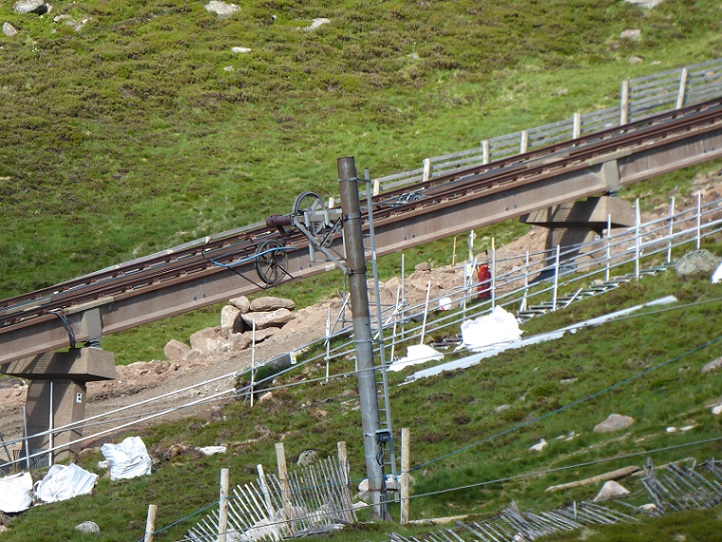

Whatever the merits of repairing the funicular, heaping piles of excavated material and imported material all the way up the construction site at the same time is not a sensible idea in a mountain environment. The work should have been phased. By luck Highlands and Islands Enterprise may get away with it……………unlike those developers in Japan.
Altering the ecology of the mountain
While a reasonable amount of care was taken to protect the mountain environment at Cairn Gorm when the funicular was originally constructed, the extensions to the existing piers has increased its footprint considerably.

The amount of concrete – 900 kg of CO2 is emitted in the fabrication of every ton of cement – being added to the funicular to prop it up and stop it sliding downhill is considerable.
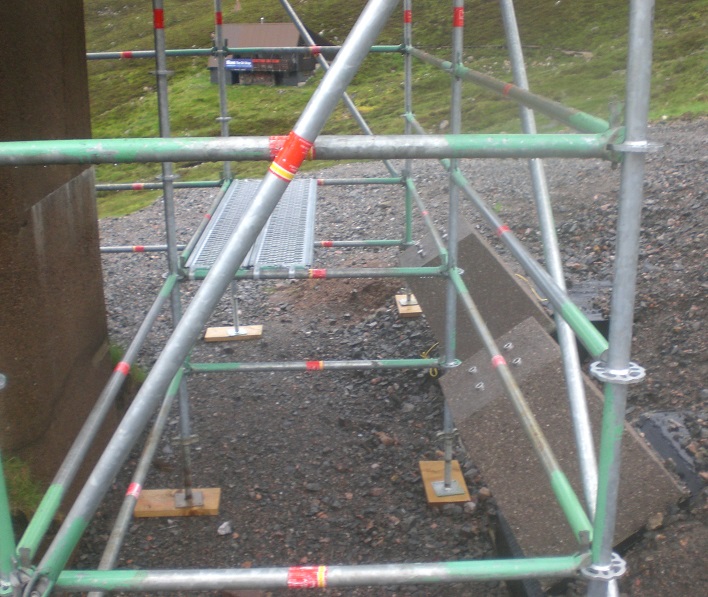
As well as the concrete, significant quantities of imported aggregate have been used in the construction. Together they have altered what remained of the natural granite based soils around the funicular and will change the drainage patterns, with unpredictable consequences.
The cost of removing all this additional concrete and material once the funicular does reach the end of its life would be enormous. The decision to repair of the funicular means it never will. HIE has effectively altered the ecology of the mountain until another ice age or plate tectonics do what it won’t, clean up and restore properly.
Beside the impact of the actual construction, the area around was being treated like any old construction site with little regard for the natural environment.
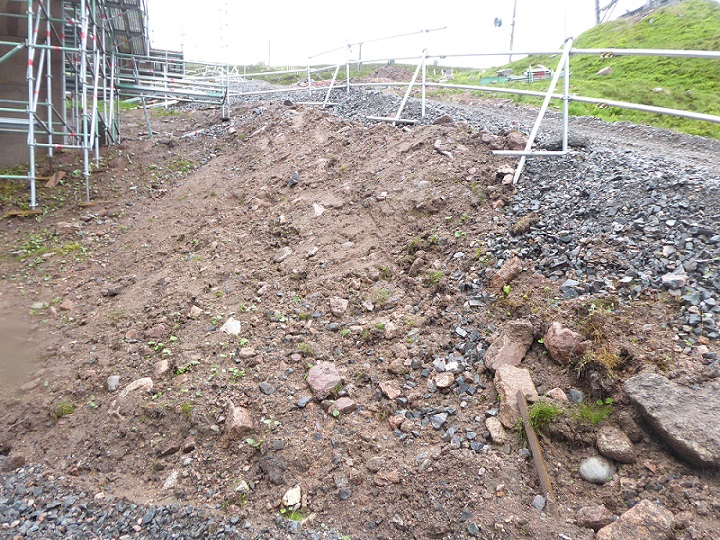
The planning application claimed that the original funicular construction tracks above the mid-station which had been restored would be uncovered and re-used. This always was nonsense. What the photo shows it that Balfour Beatty has been allowed to bring in imported aggregate to surface a new “temporary” access track. It is hard to see how this can ever be removed – it is spilling all over the mountain – and its still not clear what will be done with this and all the surplus material displaced from the pits. Spread it around, perhaps, and hope for the best?
What was being done to the peaty areas was as bad:

“SUSTAINABLE PEAT MANAGEMENT: SEPA welcomes the utilisation of existing tracks where possible and acknowledge that there is little scope for mitigation in terms of reducing volumes of excavated peat with regards to the proposed new pier supports [yet more carbon emissions]. However, there appears to be scope for further mitigation in relation to the new temporary tracks proposed with a significant volume of peat estimated to be excavated for these in table 3 of the Outline Peat Management Plan and SEPA therefore request that all temporary tracks where
peat would otherwise be excavated comprise of geotextile or plastic track matting unless there is a significant technical reason why this is not feasible”. (Extract from the CNPA Committee Report on the Planning Application).
The failure of the CNPA to enforce planning conditions

According to the plans approved by the CNPA Planning Committee, the width of the construction corridor for the funicular repairs works would be:
- 20m where new bearings and pier strengthening was required (generally lower down the hill – top left in map above);
- 30m where new props were required to strengthen the piers which were toppling over (generally from 10 piers below the mid station to the funicular tunnel);
- 40m for the six piers above the mid-station; and
- a few section where where there were projecting access spurs and storage areas.
Just why some temporary storage areas were included in the construction site and others were not, was never explained:

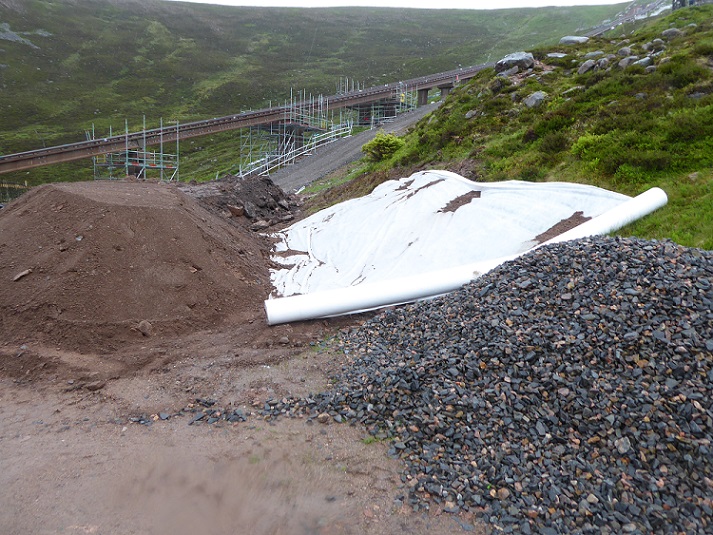
To their credit, the Scottish Environment Protection Agency in their response to the planning application had queried the construction site area and noted “that should the construction site area be over 4ha, a Construction Site Licence (CSL) would be required.” That never appears to have been followed up by the CNPA.
It is now abundantly clear that significant stretches of the construction site are far wider than those shown in the plans and this is in planning terms having a further completely “unnecessary” impact on the surrounding natural environment.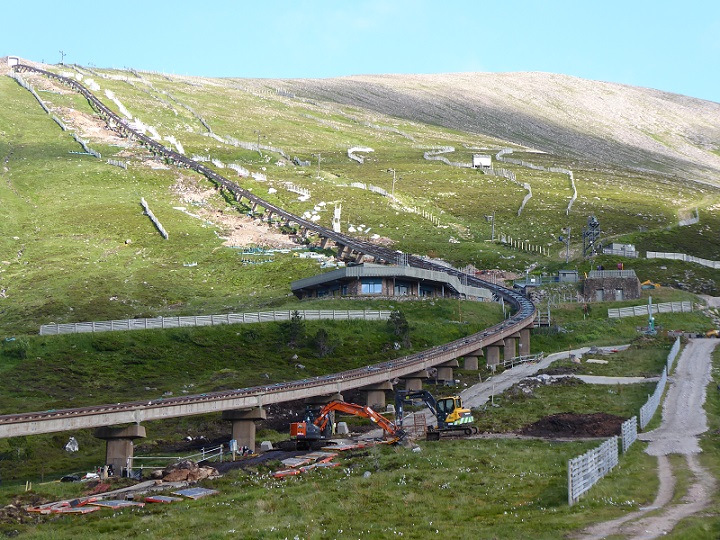
Evidence of work impact on areas outwith the construction corridor, by the heap of soil/peat lower right and higher up the mountain the construction has clearly affected an area more than 30m wideSo why didn’t the Cairngorms National Park Authority insist the construction corridor was first sized and then marked out properly? Why has it since not taken enforcement action o this and other issues (like failure to store vegetation)? It was quite predictable that, given their record, HIE and Cairngorm Mountain Scotland Ltd would make little effort to ensure planning conditions were kept, so why weren’t CNPA Planning staff out on site each day?
The answer is not just a matter of resources – the poor frontline staff who are technically responsible for enforcing planning conditions don’t have time to do so – it is also a failure of will on the part of the CNPA. This gives out a terrible message, if Cairn Gorm – the mountain that should have been the jewel in the crown of the Cairngorms National Park – cannot be protected, then no mountain in Scotland is safe from the type of depredations that are currently being carried out there in the name of sustainable development.
It is important that those who care about Cairn Gorm keep protesting and continue to make the argument that HIE should have no place on the mountain. In a further post I will look at further evidence from my visit that suggests the repairs to the funicular are botched in conception and may not work that long.
This all reads like a construction site that the builders consider hidden from view, where they can do anything they want without consideration of the planning consent. It’s hardly in a city centre for everyone to see, after all (so they seem to think). Who’ll notice if we put piles of imported materials here or there, dig the ground up wherever we need, and build unnecessary storage areas – it’s just a remote Scottish hill, isn’t it? A few passing walkers? The first statement in Balfour Beatty’s environmental policy is “Balfour Beatty is committed to protecting and where appropriate enhancing the environment in which we operate”.
I think it’s likely that the developers or their consultants drew the application line quite tightly on their plans and before really knowing how the work would be carried out in detail. Generally the smaller the area within the red application line the smaller the planning fee for the developer. However, any amount saved will be miniscule by comparison with the overall public spend on this, though at least it would have gone directly to hard pressed planning services.
Those of us who objected to the planning application to repair the funicular will remember that the plans were ‘faked’ to ensure that only the immediate site of pillar repair work was included in the planning consent area. This was to avoid the application becoming a Major planning application which carries with it much more planning requirements – not just cost.
In my objection, which I sent to all CNPA Board members I included the words, “There is one important matter that is of material concern. This planning application meets all the requirements and legal definitions of a major development (see Scottish Planning Series Circular 5 2009: Hierarchy of Developments), but has not been treated as a major development by CNPA planners. Instead a dangerous workaround of dubious legality has been described in the planning report document you have received on this application.”
I believe CNPA was knowingly complicit in this trickery. Then we find that even all the fake boundaries included in the application (which were deemed outside of the planning consent area) have been expanded ad hoc to meet the contractor’s wishes.
There are numerous examples of applicants for planning applications making clearly inaccurate statements or producing clearly misleading supporting documents. I’ve yet to find where any developer has had action taken against them for negligence with planning application information ….. far less for being deliberately untruthful.
Then we have the lack of enforcement by CNPA Planners. You give them the benefit of the doubt, Nick, that they are under-resourced and overworked. I have struggled to get CNPA staff to even visit a development site on their doorstep to view breaches of planning conditions, far less take enforcement action. I believe the problem lies with ‘guidance’ all the way from SG Local Government & Communities Directorate to give a soft touch to all developers, and to some poor legal decisions where in the past developers have taken planning authorities to court for enforcements that have deemed not to be commensurate with the breach.